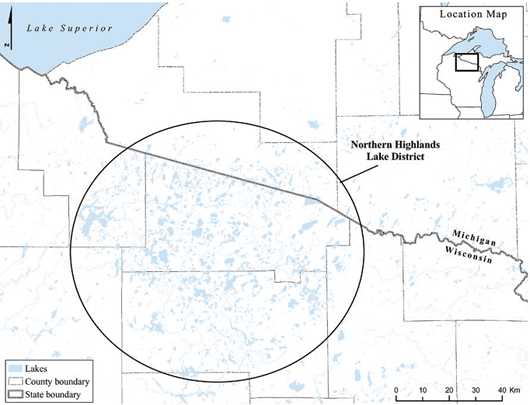United States
The Northern Highlands Lake District, Wisconsin
Contact Information
- Dr. Steve Carpenter, Professor
Center for Limnology
University of Wisconsin
Madison, WI 53706
USA
srcarpen@wisc.edu
Lead Institution
University of Wisconsin, Madison. The assessment also involves people
from the local business community, the Lac du Flambeau Band of Lake Superior
Chippewa Indians, other residents of the region, recreational users, local
government, NGOs, media representatives, and the State management agency
(the Wisconsin Department of Natural Resources, or WDNR).
Funding for this assessment is mainly from University of Wisconsin.
Regional Background and Project Summary
The Northern Highlands Lake District (NHLD) covers 5,300 square kilometers
of the extreme northern part of Wisconsin, USA. It is to the south and east
of Lake Superior at a latitude of 46º N.
The NHLD is in transition from a sparsely settled region to a more densely
populated one. Expected changes offer benefits to northern Wisconsin residents,
but also threaten to degrade the ecosystem services that residents ultimately
rely on. Because the future of this region is uncertain, it is difficult
to make decisions that will avoid potential risks and take advantage of
potential opportunities.
Key issues affecting human well-being and the ability of ecosystems to
continue to deliver the services upon which the population depends derive
from the rapid transition of the region driven by development. Conflict
centers on multiple demands for limited land and water, especially limited
lakeshore land. Socio-ecological challenges include:
- growth and diversification of the economy,
- maintenance of traditional values (amid multiple definitions of
‘‘traditional’’),
- competing use of resources (such as land for timber harvest versus
recreational use),
- incompatible recreational uses (such as motorized versus silent
outdoor recreation),
- population growth,
- impacts of forest management,
- overpopulation of deer,
- negative impacts of lakeshore development on water quality and fisheries,
- exotic species, and
- impacts of fish harvesting and stocking.
Many of these issues are addressed through workshops, scenarios, and
scientific research.
We are addressing the ecosystem services provided by lakes in the NHLD
in order to assess the sustainability of ecosystem services, we need to
understand how different people use and transform ecosystems, the dynamics
of ecosystems, and the external forces that are shaping the region. We therefore
examine interactions among population and economic growth, lakeshore development,
social conflict, regional-local institutions, forestry, hunting, fishing,
biodiversity, ecotourism, ethno-tourism, and other forms of recreation in
the region.
Ecosystem Services
Provisioning services (forestry, hunting, fishing); cultural services
(eco- and ethno- tourism, lake and lakeside recreation). Additionally, biodiversity
is assessed.
Key Features of Assessment Region
Lakes are a key characteristic of the NHLD, with thousands of natural
lakes that together cover about 11% of the surface area in the region. An
additional 25% of the area is wetland. Most lakes in this area are clear,
with low amounts of nutrients. Most of the lakes receive their water from
precipitation, although many are seepage lakes that are connected only by
groundwater. Determinants of water quality include water color, nutrient
input, presence of toxins (such as mercury), and presence of disease-causing
organisms (such as Giardia ). At the present time, water quality is good
in most of the lakes. Many of the lakes support high-quality game fisheries.
Walleye ( Stizostedion vitreum ) is the most popular sport and table fish.
Important sport fisheries exist for muskellunge ( Esox masquinongy ), northern
pike ( Esox lucius ), black basses ( Micropterus spp.), and diverse panfish.
Quality of sport fishing is sensitive to harvest, as is evident from the
high catch rates and abundant trophy-size fishes in lakes that are managed
with regulations that restrict harvest. In addition to fish harvest, other
important effects of people on the lakes include removal of woody habitat
from near shore areas, introduction of destructive exotic species (especially
rusty crayfish, Orconectes rusticus , rainbow smelt ( Osmerus mordax ),
and Eurasian milfoil Myriophyllum spicatum ), nutrient enrichment, deposition
of mercury (from coal-fired industries far to the west of the NHLD), and
hydrological modifications.
Ecosystem services derived from the NHLD are dominated by tourism and
forest products. Tourism is based on the natural beauty of the area, the
abundant wildlife (including diverse non-game species plus popular game
species such as ducks, grouse and deer), and the legendary fishing opportunities.
Ethno-tourism, centered on the Lac du Flambeau reservation, is a small but
growing sector of the economy. Important outdoor activities include boating
(from paddlecraft to large motorized boats), all-terrain vehicle use, and
snowmobiling. Forestry centers on pulpwood for Wisconsin’s thriving paper
industry. In addition to these readily quantified ecosystem services, the
NHLD contributes a number of ecosystem services that are not often quantified.
Two important tributaries of the Mississippi River, the Wisconsin and St.
Croix rivers, arise in the NHLD. Waters from the NHLD also flow to Lake
Superior. Thus the NHLD is an important source of clean water for two of
the major river systems of North America, the Mississippi and the St. Lawrence.
The aggrading forests of the NHLD may be significant carbon sinks (although
the carbon budget of the landscape has not yet been quantified). The thousands
of individual lakes harbor remarkable genetic diversity of aquatic organisms.
This diversity has been quantified only partially. Unfortunately, fish stocking
practices and invasions of exotic species are eroding this diversity of
aquatic resources.
Project Outputs
In addition to producing assessment reports and scientific articles,
we intend to become a ‘‘virtual center’’ for integrated, science-based understanding
of the NHLD. We will maintain an ongoing discussion with local people and
develop tools, such as scenarios, in collaboration with them. We aim to
express our findings in plain language, simple computer games, art, and
other formats that are widely understandable. We will establish a network
of citizens in the region who are knowledgeable about navigating long-term
change.
For further information

Figure 1. Assessment area for Wisconsin SGA.